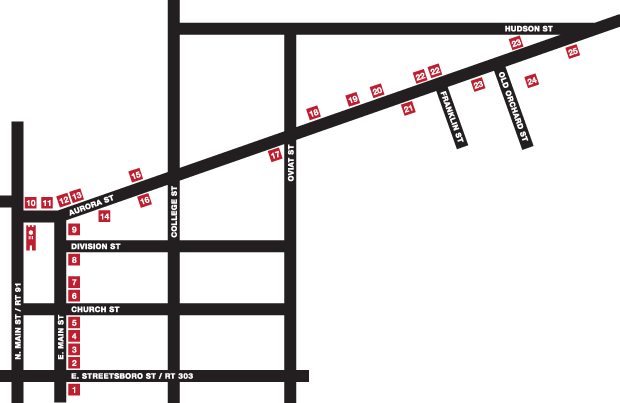Thurs, Jan 8, 7:00pm at Barlow Community Center. Former park superintendent John Debo discusses Cuyahoga Valley National Park at 50.
Tour #2: A Walking Tour of East Main & Aurora Streets
Approximate Walking Time: 30-40 minutes
Many of the areas and buildings on this tour of Hudson’s downtown residential neighborhood are listed in the National Register of Historic Places. Those properties with the white ”HHA” marker have been researched and authenticated by Hudson Heritage Association and may be noteworthy for their architecture, their past ownership or for the activities that took place within them. The markers typically carry the name of the original owner of the property.
This area is blessed with a range of architecture representative of the Western Reserve and other styles of significance. Be sure to note the features and elements of each building that help make Hudson such a rich reflection of its past and its citizenry – a storied group of individuals who were determined to build a community reflecting the elegance of New England in the Ohio wilderness.
Read A Brief History of Hudson
For a better mobile experience, click the map to view it in its own window, to reduce scrolling.
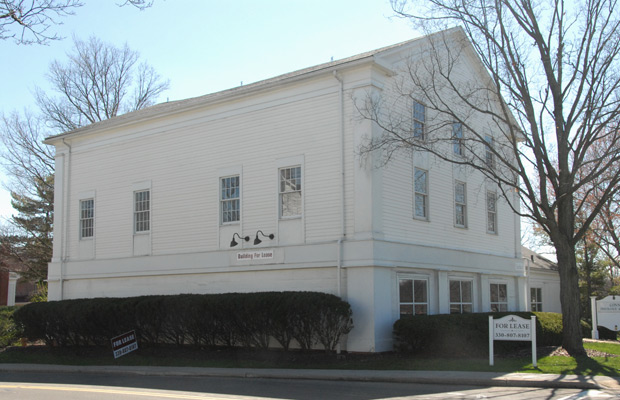 1. 5 East Streetsboro Street (1841), Free Congregational Church
1. 5 East Streetsboro Street (1841), Free Congregational Church
A much-altered Greek Revival structure built by anti-slavery supporters including John Brown’s father Own Brown, this building first served as a church for those who left the First Congregational Church over the Abolition question. It subsequently was converted to commercial use and has housed a number of enterprises. John Brown gave one of his most stirring speeches here.
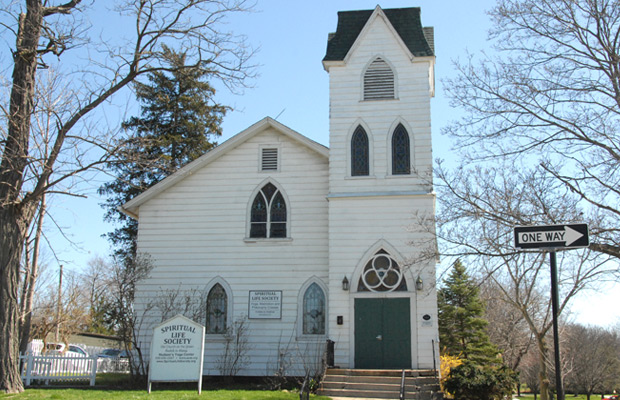 2. 7 East Main Street South (1860), Old Church on the Green
2. 7 East Main Street South (1860), Old Church on the Green
Moved from its original site on Maple Street, this building formerly housed St. Mary’s Roman Catholic Church, founded primarily to serve the Irish Catholic families who came to build the railroads in the 1840s.
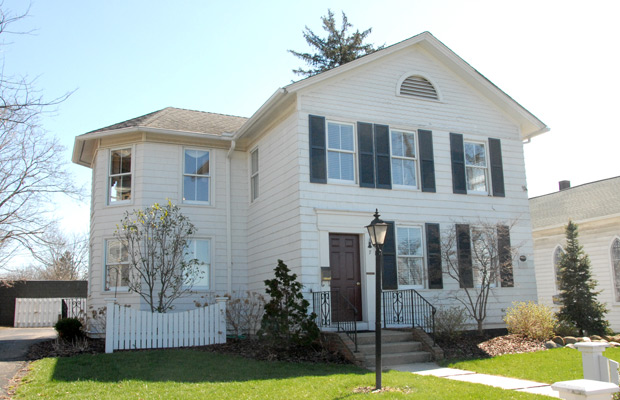 3. 7 East Main North (1825), Captain Herman Oviatt House
3. 7 East Main North (1825), Captain Herman Oviatt House
Hudson’s first store was Captain Oviatt’s trading post. At various times, this building housed the Hudson Young Ladies’ Seminary and served as the rectory for St. Mary’s Church. Oviatt, who came to Hudson in 1801, was the town’s first mayor and endowed the first professorship at Western Reserve College (now Western Reserve Academy).
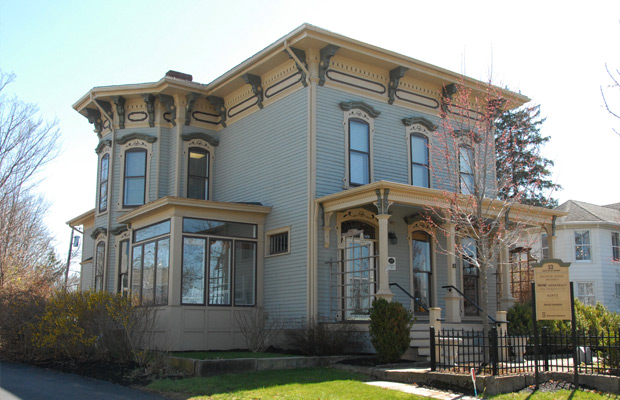 4. 13 East Main North (1877), Sebastian Miller House
4. 13 East Main North (1877), Sebastian Miller House
With its bracketed eaves, this house is an excellent example of the Italianate style.
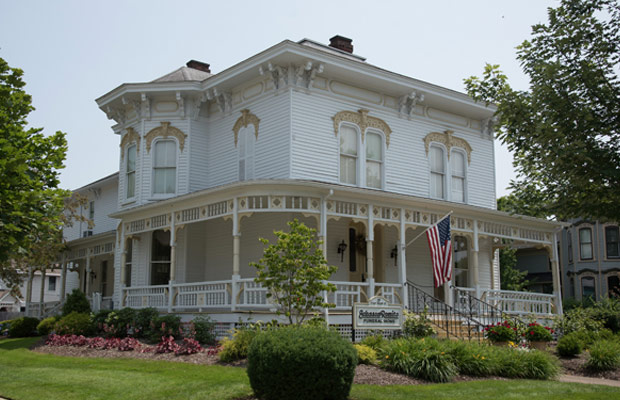 5. 19 East Main Street (1836/1877), Town-Neibel House
5. 19 East Main Street (1836/1877), Town-Neibel House
When built in 1836 by carpenter/architect Leander Starr for Dr. Israel Town, this was a high-style, columned Greek Revival house. In 1877, it was Victorianized, losing both its wings, one of which became the house at 25 Streetsboro Street.
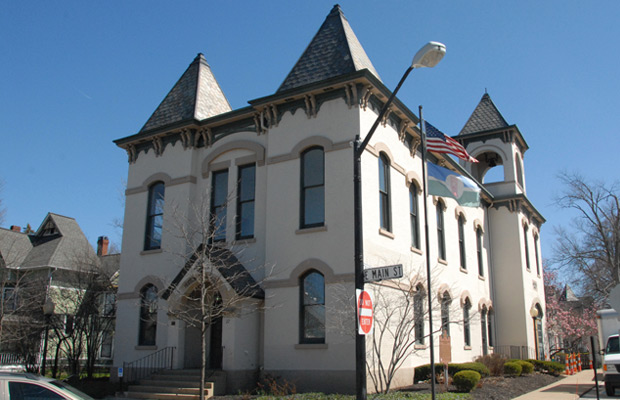 6. 27 East Main Street (1841), Hudson Town Hall
6. 27 East Main Street (1841), Hudson Town Hall
Built on the site of the original 1820 Congregational Church, which was abandoned when the congregation moved to Aurora Street, this Italianate structure served as the seat of town government from 1879 until 2013. It is now used for various government business and is home to Hudson’s Fire Museum and Destination Hudson.
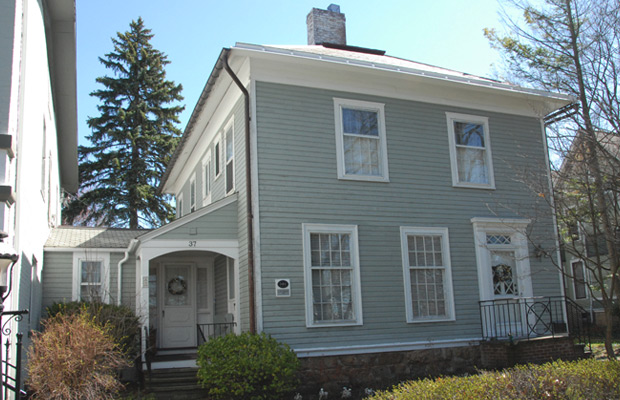 7. 35 East Main Street (1889), A.W. Lockhart House
7. 35 East Main Street (1889), A.W. Lockhart House
This house was built on the foundation of the Norman Baldwin house, which was moved around the corner to Division Street. Lockhart is remembered as the proprietor of the saloon where the tragic Main Street fire of 1892 began.
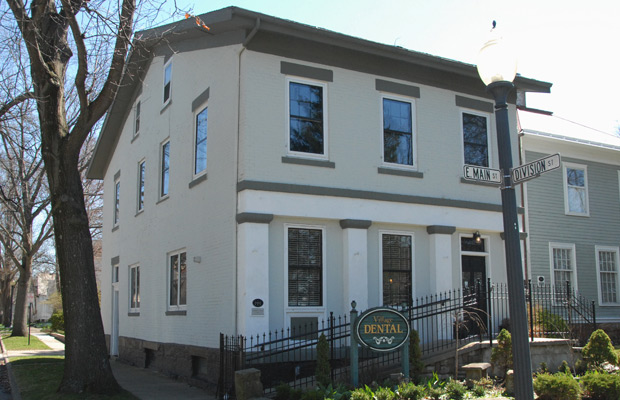 8. 41 East Main Street (1841), The Ellsworth Store
8. 41 East Main Street (1841), The Ellsworth Store
Built as the dry goods store of Edgar B. Ellsworth, father of Hudson’s great benefactor James W. Ellsworth, this is one of the oldest commercial buildings in Hudson. E. B. Ellsworth was a large landowner and backer of the ill-fated railroad boom of the 1850s.
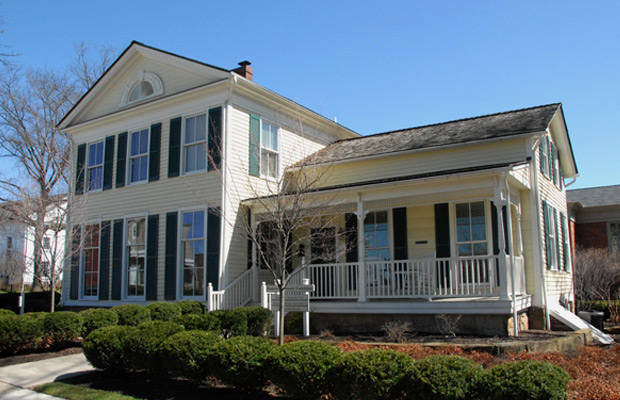 9. 49 East Main Street (1834), Baldwin Babcock House
9. 49 East Main Street (1834), Baldwin Babcock House
Hudson’s first free library was established through the generosity of Caroline Baldwin Babcock, whose father Frederick Baldwin built this Greek Revival house. Appropriately, her girlhood home served as the home of the Hudson Library and Historical Society for many years. It now houses the Hudson Community Foundation and Hudson Heritage Association.
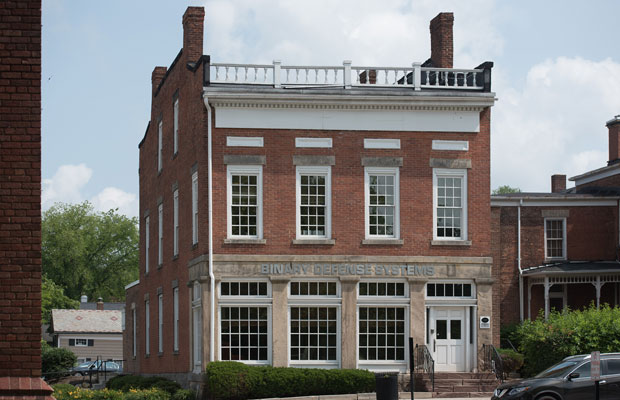 10. 5 Aurora Street (1839), Brewster Store
10. 5 Aurora Street (1839), Brewster Store
This Federal-style building has been the home of commercial endeavors since it opened as Kent and Brewster’s Dry Goods Store in 1839. It was restored in 1908 by James Ellsworth. The attempt to demolish it in 1962 prompted the formation of Hudson Heritage Association.
 11. 9 Aurora Street (1853), Brewster Mansion
11. 9 Aurora Street (1853), Brewster Mansion
One of the few stone Gothic Revival buildings in the Western Reserve, this building served as the home of the merchant A. A. Brewster. Brewster expected his home would be one of many great mansions built in Hudson with the coming of the railroads.
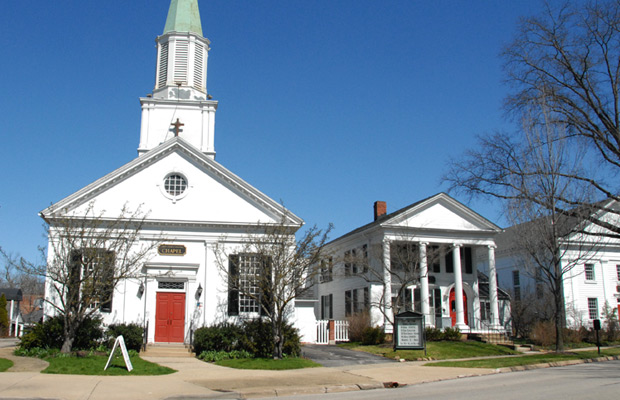 12. 19 Aurora Street (1930/1993), Christ Church Episcopal Chapel and Church
12. 19 Aurora Street (1930/1993), Christ Church Episcopal Chapel and Church
The present Colonial Revival Chapel, built in 1930, replaced the original wooden Gothic Revival church of 1846. The congregation, organized in 1842, expanded to the larger church to the east in 1993.
 13. 21 Aurora Street (1834), Isham-Beebe House
13. 21 Aurora Street (1834), Isham-Beebe House
Duncan Beebe, A. A. Brewster’s son-in-law and successor as proprietor of his store, bought this house from Warren Isham, editor of two of Hudson’s early newspapers. The only remaining Greek Revival house in Hudson with free-standing columns, it serves today as the Episcopal parish house.
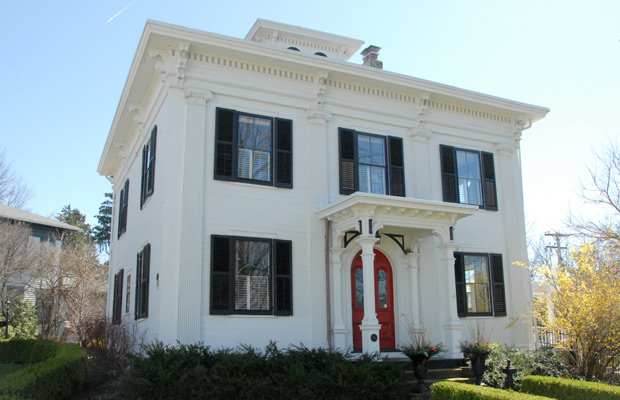 14. 30 Aurora Street (1826), Whedon-Farwell House
14. 30 Aurora Street (1826), Whedon-Farwell House
This high-style Federal residence was designed by master architect/builder Lemuel Porter for Benjamin Whedon, who came to Hudson from Connecticut in 1805. It has served as an inn, primary school and young ladies’ seminary. The roof and front entry were remodeled in the Victorian style in 1870.
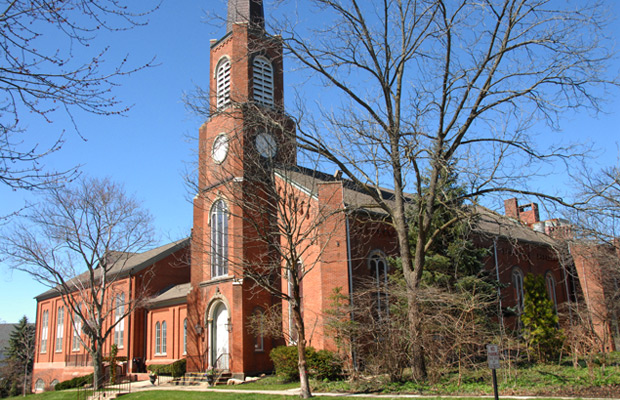 15. 47 Aurora Street (1865), First Congregational Church
15. 47 Aurora Street (1865), First Congregational Church
Simeon Porter, son of Lemuel Porter, designed this Romanesque structure as the second home to the congregation.
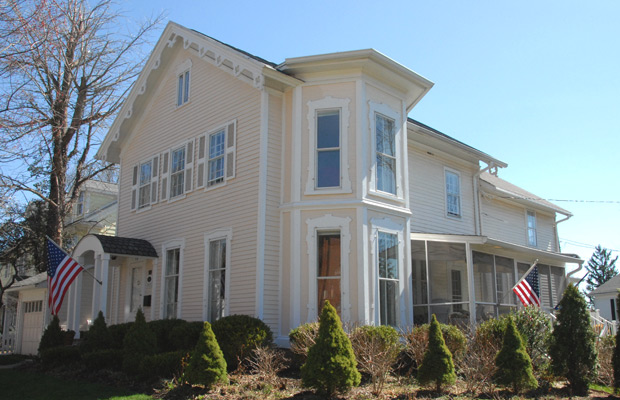 16. 48 Aurora Street (1829), Kirkham-Porter House
16. 48 Aurora Street (1829), Kirkham-Porter House
Built by George Kirkham, an early lawyer in the Western Reserve, this home was bought by Margaret Porter, widow of Lemuel Porter, in 1833. Later, it was used as parsonage for the Congregational Church across the street.
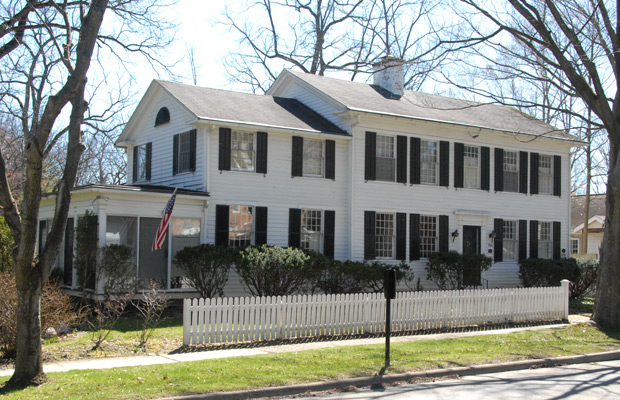 17. 106 Aurora Street (1830), Harlow Davis House
17. 106 Aurora Street (1830), Harlow Davis House
This Federal-style house was built by Harlow Davis, a local carpenter/joiner. It was later occupied by Henry W. Sabin, whose stencil work graced many mid-19th century houses in the area. At one time, the house served as a college dormitory.
 18. 129 Aurora Street (1827), Crisp-Raymond House
18. 129 Aurora Street (1827), Crisp-Raymond House
After Congregational minister William Hanford settled on Aurora Street, his sister Mary Raymond built a similar house adjoining her brother’s land. Two 20th century houses separate them now. The house became a girls’ school and was owned for several generations by the Crisp family, which gave it to Western Reserve Academy to use as a faculty house.
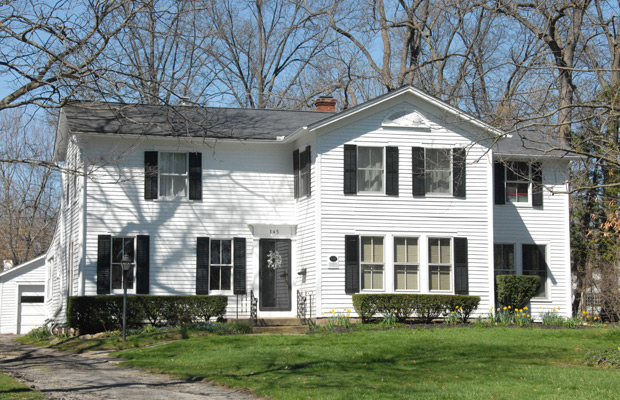 19. 145 Aurora Street (1825), Rev. William Hanford House
19. 145 Aurora Street (1825), Rev. William Hanford House
This was probably built around the log house where Hudson’s first Congregational minister lived. Beriah Green, a fiery Abolitionist at the college, lived here and Emily Metcalf ran a school for girls here. The Heidenreich family called it home for 65 years.
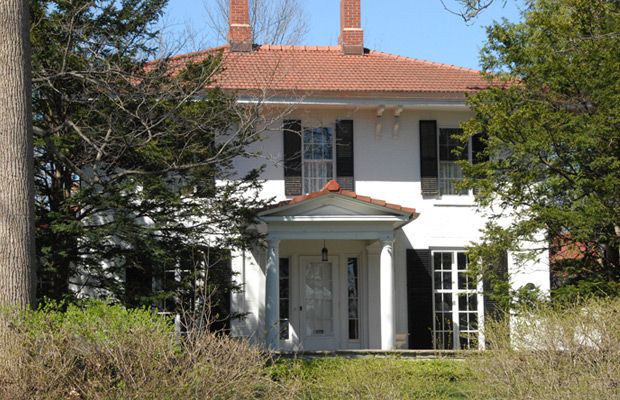 20. 161 Aurora Street (1854), Seymour Straight House
20. 161 Aurora Street (1854), Seymour Straight House
Built during Hudson’s railroad boom, this large brick house was later home to Seymour Straight, a prosperous cheese manufacturer.
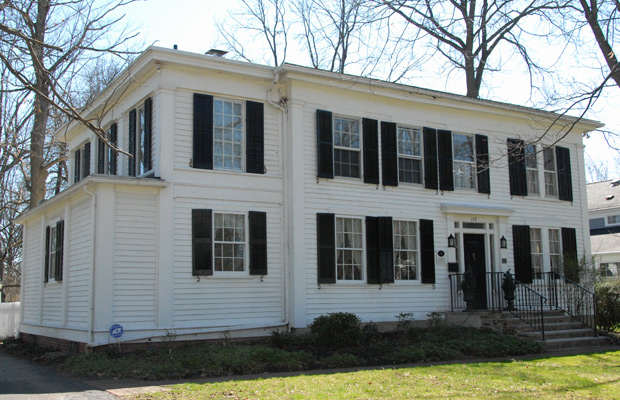 21. 172 Aurora Street (1850/1877), I. T. Frary House
21. 172 Aurora Street (1850/1877), I. T. Frary House
Moved to its present location in 1877, this house was later expanded to its current size. It was the home of I. T. Frary, author of the influential book, Early Homes of Ohio.
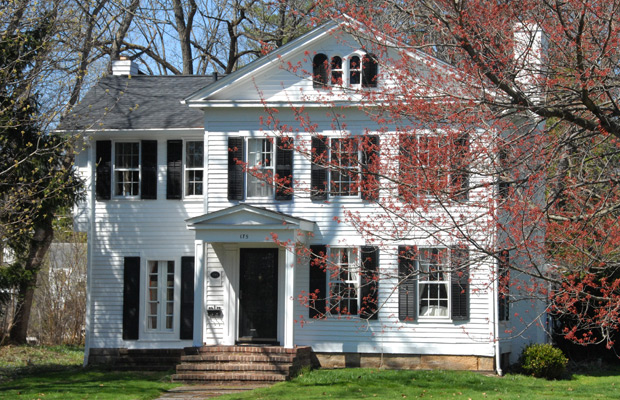
 22. 175 Aurora Street (1854), Pierpont Edwards House; 183 Aurora Street (1854), J. W. Smith House
22. 175 Aurora Street (1854), Pierpont Edwards House; 183 Aurora Street (1854), J. W. Smith House
These two houses, along with 134 Aurora Street, were similar late Greek Revival residences built in 1854 as part of a subdivision called Day’s Addition, meant to house officials in the railroad venture. The house at 183 has had the fewest changes to its original look. Both 175 and 134 have “Tablet of Moses” windows in their front-facing gables.

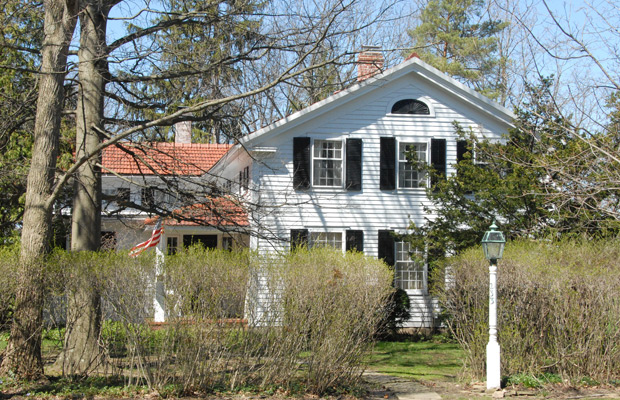 23. 204 Aurora Street, 233 Aurora Street (1830), Both of these transitional Federal/Greek Revival houses were moved from their original locations by J. W. Ellsworth in the early 20th century and used as guest houses for his nearby estate, Evamere.
23. 204 Aurora Street, 233 Aurora Street (1830), Both of these transitional Federal/Greek Revival houses were moved from their original locations by J. W. Ellsworth in the early 20th century and used as guest houses for his nearby estate, Evamere.
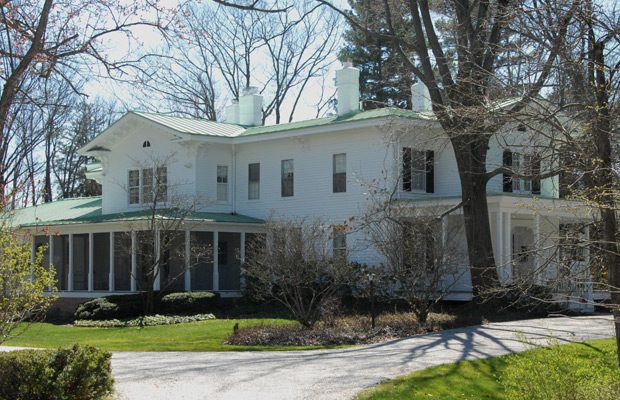 24. 230 Aurora Street (1860), Henry Hosford House
24. 230 Aurora Street (1860), Henry Hosford House
This Italianate house was designed and built by Orin Porter, youngest son of Lemuel Porter, for college professor Henry Hosford. It is a duplicate of Orin Porter’s own house at 240 College Street built a year later.
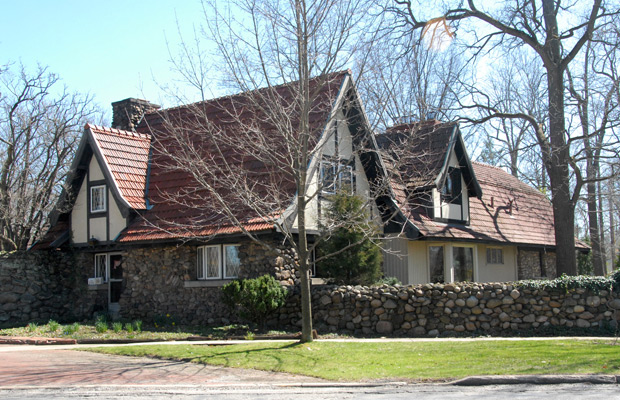 25. 250 Aurora Street (1898), Evamere Gatehouse
25. 250 Aurora Street (1898), Evamere Gatehouse
This Tudor Revival gatehouse, now enlarged, is all that remains of J.W. Ellsworth’s estate called Evamere. The architect was J.W.C Corbusier, who designed or remodeled many Hudson buildings for Mr. Ellsworth.
Approximate Walking Time: 30-40 minutes
Many of the areas and buildings on this tour of Hudson’s downtown residential neighborhood are listed in the National Register of Historic Places. Those properties with the white ”HHA” marker have been researched and authenticated by Hudson Heritage Association and may be noteworthy for their architecture, their past ownership or for the activities that took place within them. The markers typically carry the name of the original owner of the property.
This area is blessed with a range of architecture representative of the Western Reserve and other styles of significance. Be sure to note the features and elements of each building that help make Hudson such a rich reflection of its past and its citizenry – a storied group of individuals who were determined to build a community reflecting the elegance of New England in the Ohio wilderness.
For a better mobile experience, click the map to view it in its own window, to reduce scrolling.
 1. 5 East Streetsboro Street (1841), Free Congregational Church
1. 5 East Streetsboro Street (1841), Free Congregational Church
A much-altered Greek Revival structure built by anti-slavery supporters including John Brown’s father Own Brown, this building first served as a church for those who left the First Congregational Church over the Abolition question. It subsequently was converted to commercial use and has housed a number of enterprises. John Brown gave one of his most stirring speeches here.
 2. 7 East Main Street South (1860), Old Church on the Green
2. 7 East Main Street South (1860), Old Church on the Green
Moved from its original site on Maple Street, this building formerly housed St. Mary’s Roman Catholic Church, founded primarily to serve the Irish Catholic families who came to build the railroads in the 1840s.
 3. 7 East Main North (1825), Captain Herman Oviatt House
3. 7 East Main North (1825), Captain Herman Oviatt House
Hudson’s first store was Captain Oviatt’s trading post. At various times, this building housed the Hudson Young Ladies’ Seminary and served as the rectory for St. Mary’s Church. Oviatt, who came to Hudson in 1801, was the town’s first mayor and endowed the first professorship at Western Reserve College (now Western Reserve Academy).
 4. 13 East Main North (1877), Sebastian Miller House
4. 13 East Main North (1877), Sebastian Miller House
With its bracketed eaves, this house is an excellent example of the Italianate style.
 5. 19 East Main Street (1836/1877), Town-Neibel House
5. 19 East Main Street (1836/1877), Town-Neibel House
When built in 1836 by carpenter/architect Leander Starr for Dr. Israel Town, this was a high-style, columned Greek Revival house. In 1877, it was Victorianized, losing both its wings, one of which became the house at 25 Streetsboro Street.
 6. 27 East Main Street (1841), Hudson Town Hall
6. 27 East Main Street (1841), Hudson Town Hall
Built on the site of the original 1820 Congregational Church, which was abandoned when the congregation moved to Aurora Street, this Italianate structure served as the seat of town government from 1879 until 2013. It is now used for various government business and is home to Hudson’s Fire Museum and Destination Hudson.
 7. 35 East Main Street (1889), A.W. Lockhart House
7. 35 East Main Street (1889), A.W. Lockhart House
This house was built on the foundation of the Norman Baldwin house, which was moved around the corner to Division Street. Lockhart is remembered as the proprietor of the saloon where the tragic Main Street fire of 1892 began.
 8. 41 East Main Street (1841), The Ellsworth Store
8. 41 East Main Street (1841), The Ellsworth Store
Built as the dry goods store of Edgar B. Ellsworth, father of Hudson’s great benefactor James W. Ellsworth, this is one of the oldest commercial buildings in Hudson. E. B. Ellsworth was a large landowner and backer of the ill-fated railroad boom of the 1850s.
 9. 49 East Main Street (1834), Baldwin Babcock House
9. 49 East Main Street (1834), Baldwin Babcock House
Hudson’s first free library was established through the generosity of Caroline Baldwin Babcock, whose father Frederick Baldwin built this Greek Revival house. Appropriately, her girlhood home served as the home of the Hudson Library and Historical Society for many years. It now houses the Hudson Community Foundation and Hudson Heritage Association.
 10. 5 Aurora Street (1839), Brewster Store
10. 5 Aurora Street (1839), Brewster Store
This Federal-style building has been the home of commercial endeavors since it opened as Kent and Brewster’s Dry Goods Store in 1839. It was restored in 1908 by James Ellsworth. The attempt to demolish it in 1962 prompted the formation of Hudson Heritage Association.
 11. 9 Aurora Street (1853), Brewster Mansion
11. 9 Aurora Street (1853), Brewster Mansion
One of the few stone Gothic Revival buildings in the Western Reserve, this building served as the home of the merchant A. A. Brewster. Brewster expected his home would be one of many great mansions built in Hudson with the coming of the railroads.
 12. 19 Aurora Street (1930/1993), Christ Church Episcopal Chapel and Church
12. 19 Aurora Street (1930/1993), Christ Church Episcopal Chapel and Church
The present Colonial Revival Chapel, built in 1930, replaced the original wooden Gothic Revival church of 1846. The congregation, organized in 1842, expanded to the larger church to the east in 1993.
 13. 21 Aurora Street (1834), Isham-Beebe House
13. 21 Aurora Street (1834), Isham-Beebe House
Duncan Beebe, A. A. Brewster’s son-in-law and successor as proprietor of his store, bought this house from Warren Isham, editor of two of Hudson’s early newspapers. The only remaining Greek Revival house in Hudson with free-standing columns, it serves today as the Episcopal parish house.
 14. 30 Aurora Street (1826), Whedon-Farwell House
14. 30 Aurora Street (1826), Whedon-Farwell House
This high-style Federal residence was designed by master architect/builder Lemuel Porter for Benjamin Whedon, who came to Hudson from Connecticut in 1805. It has served as an inn, primary school and young ladies’ seminary. The roof and front entry were remodeled in the Victorian style in 1870.
 15. 47 Aurora Street (1865), First Congregational Church
15. 47 Aurora Street (1865), First Congregational Church
Simeon Porter, son of Lemuel Porter, designed this Romanesque structure as the second home to the congregation.
 16. 48 Aurora Street (1829), Kirkham-Porter House
16. 48 Aurora Street (1829), Kirkham-Porter House
Built by George Kirkham, an early lawyer in the Western Reserve, this home was bought by Margaret Porter, widow of Lemuel Porter, in 1833. Later, it was used as parsonage for the Congregational Church across the street.
 17. 106 Aurora Street (1830), Harlow Davis House
17. 106 Aurora Street (1830), Harlow Davis House
This Federal-style house was built by Harlow Davis, a local carpenter/joiner. It was later occupied by Henry W. Sabin, whose stencil work graced many mid-19th century houses in the area. At one time, the house served as a college dormitory.
 18. 129 Aurora Street (1827), Crisp-Raymond House
18. 129 Aurora Street (1827), Crisp-Raymond House
After Congregational minister William Hanford settled on Aurora Street, his sister Mary Raymond built a similar house adjoining her brother’s land. Two 20th century houses separate them now. The house became a girls’ school and was owned for several generations by the Crisp family, which gave it to Western Reserve Academy to use as a faculty house.
 19. 145 Aurora Street (1825), Rev. William Hanford House
19. 145 Aurora Street (1825), Rev. William Hanford House
This was probably built around the log house where Hudson’s first Congregational minister lived. Beriah Green, a fiery Abolitionist at the college, lived here and Emily Metcalf ran a school for girls here. The Heidenreich family called it home for 65 years.
 20. 161 Aurora Street (1854), Seymour Straight House
20. 161 Aurora Street (1854), Seymour Straight House
Built during Hudson’s railroad boom, this large brick house was later home to Seymour Straight, a prosperous cheese manufacturer.
 21. 172 Aurora Street (1850/1877), I. T. Frary House
21. 172 Aurora Street (1850/1877), I. T. Frary House
Moved to its present location in 1877, this house was later expanded to its current size. It was the home of I. T. Frary, author of the influential book, Early Homes of Ohio.

 22. 175 Aurora Street (1854), Pierpont Edwards House; 183 Aurora Street (1854), J. W. Smith House
22. 175 Aurora Street (1854), Pierpont Edwards House; 183 Aurora Street (1854), J. W. Smith House
These two houses, along with 134 Aurora Street, were similar late Greek Revival residences built in 1854 as part of a subdivision called Day’s Addition, meant to house officials in the railroad venture. The house at 183 has had the fewest changes to its original look. Both 175 and 134 have “Tablet of Moses” windows in their front-facing gables.

 23. 204 Aurora Street, 233 Aurora Street (1830), Both of these transitional Federal/Greek Revival houses were moved from their original locations by J. W. Ellsworth in the early 20th century and used as guest houses for his nearby estate, Evamere.
23. 204 Aurora Street, 233 Aurora Street (1830), Both of these transitional Federal/Greek Revival houses were moved from their original locations by J. W. Ellsworth in the early 20th century and used as guest houses for his nearby estate, Evamere.
 24. 230 Aurora Street (1860), Henry Hosford House
24. 230 Aurora Street (1860), Henry Hosford House
This Italianate house was designed and built by Orin Porter, youngest son of Lemuel Porter, for college professor Henry Hosford. It is a duplicate of Orin Porter’s own house at 240 College Street built a year later.
 25. 250 Aurora Street (1898), Evamere Gatehouse
25. 250 Aurora Street (1898), Evamere Gatehouse
This Tudor Revival gatehouse, now enlarged, is all that remains of J.W. Ellsworth’s estate called Evamere. The architect was J.W.C Corbusier, who designed or remodeled many Hudson buildings for Mr. Ellsworth.
